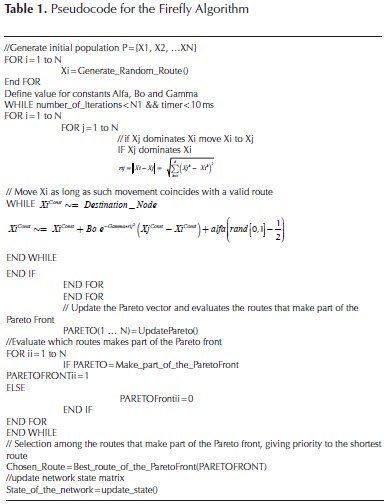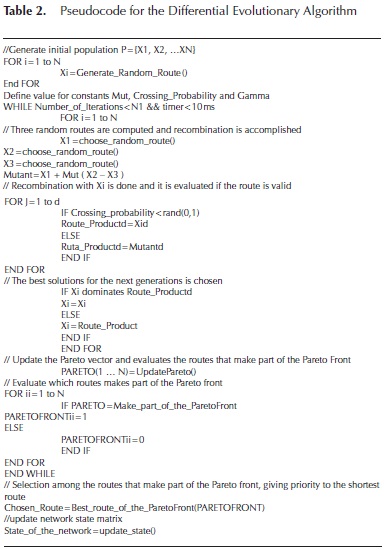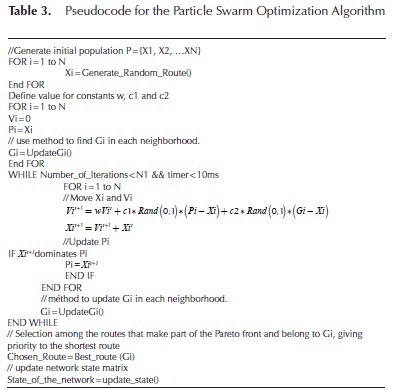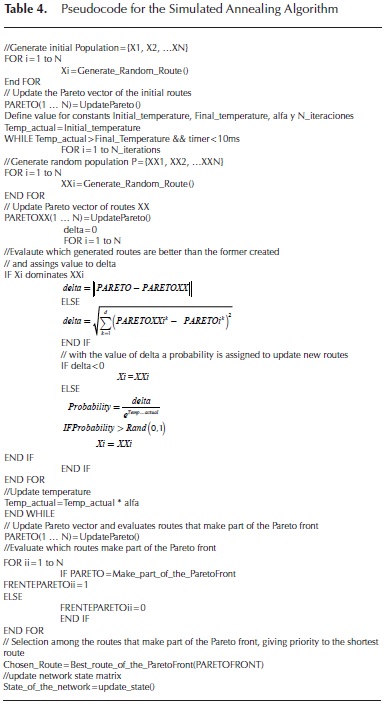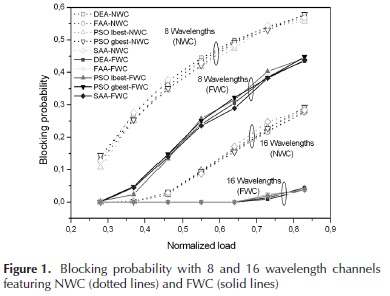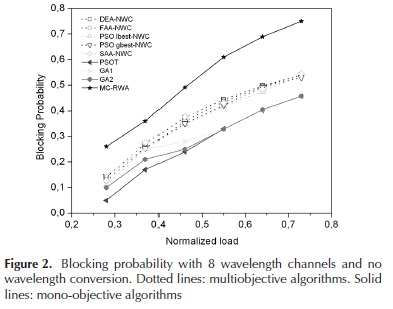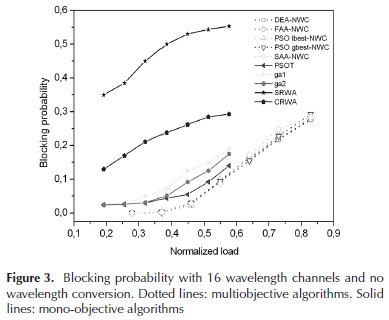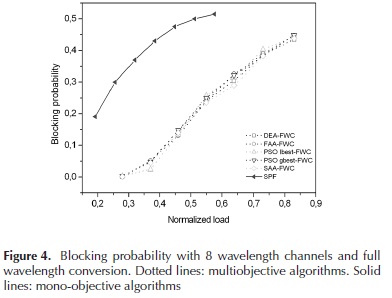Services on Demand
Journal
Article
Indicators
-
 Cited by SciELO
Cited by SciELO -
 Access statistics
Access statistics
Related links
-
 Cited by Google
Cited by Google -
 Similars in
SciELO
Similars in
SciELO -
 Similars in Google
Similars in Google
Share
Ingeniería e Investigación
Print version ISSN 0120-5609
Ing. Investig. vol.36 no.1 Bogotá Jan./June 2016
https://doi.org/10.15446/ing.investig.v36n1.50384
DOI: http://dx.doi.org/10.15446/ing.investig.v36n1.50384
Performance of multiobjective computational intelligence algorithms for the routing and wavelength assignment problem
Desempeño de algoritmos de inteligencia computacional multiobjetivo en el problema de enrutamiento y asignación de longitud de onda
J. L. Patiño1, B. M. Castañeda2, and G. A. Puerto3
1 Jorge Patiño: Electronic Engineer, Universidad Distrital Francisco José de Caldas, Colombia.
Email: jlpatinog@correo.udistrital.edu.co.
2 Bryan Montes: Electronic Engineer, Universidad Distrital Francisco José de Caldas, Colombia.
Email: bmontesc@correo.udistrital.edu.co.
3 Gustavo Puerto. PhD Telecommunications. Affiliation: Assistant Professor Universidad Distrital Francisco José de Caldas, Colombia.
Email: gapuerto@udistrital.edu.co.
How to cite: Patiño, J. L., Castañeda, B. M., & Puerto, G. A. (2016). Performance of multiobjective computational intelligence algorithms for the routing and wavelength assignment problem. Ingeniería e Investigación, 36(1), 111-117. DOI: http://dx.doi.org/10.15446/ing.investig.v36n1.50384.
ABSTRACT
This paper presents an evaluation performance of computational intelligence algorithms based on the multiobjective theory for the solution of the Routing and Wavelength Assignment problem (RWA) in optical networks. The study evaluates the Firefly Algorithm, the Differential Evolutionary Algorithm, the Simulated Annealing Algorithm and two versions of the Particle Swarm Optimization algorithm. The paper provides a description of the multiobjective algorithms; then, an evaluation based on the performance provided by the multiobjective algorithms versus mono-objective approaches when dealing with different traffic loads, different number of wavelengths and wavelength conversion process over the NSFNet topology is presented. Simulation results show that mono-objective algorithms properly solve the RWA problem for low values of data traffic and low number of wavelengths. However, the multiobjective approaches adapt better to online traffic when the number of wavelengths available in the network increases as well as when wavelength conversion is implemented in the nodes.
Keywords: Heuristic algorithms, multiobjective algorithms, optical networks, RWA problem.
RESUMEN
Este artículo presenta una evaluación de desempeño de algoritmos de inteligencia computacional basados en teoría multiobjetivo para la solución del problema de enrutamiento y asignación de longitudes de onda en redes ópticas. El estudio evalúa el algoritmo de luciérnaga, el algoritmo evolutivo diferencial, el algoritmo de enfriamiento simulado y dos versiones del algoritmo de optimización por enjambre de partículas. El artículo provee una descripción de los algoritmos multiobjetivo, y luego presenta una evaluación basada en las prestaciones de dichos algoritmos contra las generadas por propuestas mono-objetivo al tratar diferentes cargas de tráfico, número de longitudes de onda y procesos de conversión de longitud de onda sobre la topología de red NSFNet. Los resultados de simulación muestran que los algoritmos mono-objetivo resuelven adecuadamente el problema RWA para valores bajos de tráfico y número de longitudes de onda. Sin embargo, las propuestas multiobjetivo se adaptan mejor al tráfico dinámico cuando el número de longitudes de onda disponibles en la red aumenta y también cuando los nodos incorporan características de conversión de longitud de onda.
Palabras clave: Algoritmos heurísticos, algoritmos multiobjetivo, problema RWA, redes ópticas.
Received: May 3rd 2015 Accepted: November 11th 2015
Introduction
The increasing growth of data traffic consumption, which is expected to continue in the forthcoming years (Cisco Visual Networking Index, 2015), and the technological maturity reached by the optical fiber systems to allow deployments of optical networks capable of managing huge amounts of bandwidth while providing more functions other than point-to-point transmission, such as switching and forwarding, have positioned the optical fiber as the preferred means of transmission in today's high-speed and long reach data networks. These networks are known as wavelength-routing networks. A wavelength-routed network provides lightpaths to its clients i.e. optical connections carried end-to-end from a source node to a destination node using a wavelength on each intermediate link. Depending on the node capabilities, in some cases the lightpaths may be converted from one wavelength to another wavelength allowing each optical channel to be spatially reused in different parts of the network. One of the fundamental problems for the development of optical networks relies on strategies of routing and forwarding that efficiently manage the big bandwidth provided by the optical fiber. In this context, the control plane plays an important role in order to find the right lightpath using the available wavelengths. This fact allows the setting up of end-to-end connections while the blocking probability is reduced. Network blocking means that the connection between two nodes in the network was not successful due to a lack of optical resources to set up a lightpath. This aspect is known as the wavelength-dimensioning problem or Routing and Wavelength Assignment (RWA) problem when the lightpath routing process is involved in the general solution of the problem.
Depending on the type of transported traffic considered, two versions of the RWA problem can be defined. The first one is called offline RWA, in which all the lightpaths are given at once. The solution to this form of the problem is mainly useful at network planning stages. However, when the network is operational the online RWA suits better, as the problem has to be solved on demand for each lightpath at a time.
The solving of this issue is not trivial; according to the computational complexity theory, the RWA problem is considered as NP-complete, which means that it cannot be solved within a polynomial time, i.e. required time to solve any problem by means of deterministic algorithms. For this reason, traditional methods using deterministic algorithms might not be a good alternative to solve the RWA problem. Some nondeterministic algorithms may offer acceptable results; heuristic algorithms represent an alternate solution despite their iterative behavior. Different approaches from different perspectives have been proposed to solve the RWA problem. In this context, approaches based on Integer Linear Programming (ILP) where the routing and wavelength assignment were treated separately are described in (Pavarangkoon, et al., 2014), (Guitart et al., 2012), (Rahman, 2012), (Harai et al., 1997), (Subramaniam et al., 1997). Nevertheless, for large networks with broad traffic to transport, the ILP solutions have shown that potential assignation of a number of lightpaths higher than the number of wavelengths available in the network is feasible; this fact brings about network blocking. Heuristic algorithms such as Tabu search (Morley et al., 2001) and Genetic Algorithms (GA) (Bisbal et al., 2004) have shown to be more efficient in solving the RWA problem than the ILP approaches. Different proposals for the optimization of the RWA problem have also been found in scientific literature, one of them based on Ant Colony (ACO) algorithms, which have been used to solve both static RWA (Varela et al., 1999) and dynamic RWA (Shen et al., 2012), (Ngo et al., 2004).
This paper is focused on assessing the performance of the solution to the online RWA problem using multiobjective theory (Coello et al., 2007). The reason for using such paradigm relies on the necessity of solving more than one objective, aiming to find routes that better adapt to the online requests while reducing the blocking probability when the network is operational. The targeted objectives defined in this work are: the shortest number of hops, the use of a minimum number of wavelength converters along the path, the average number of available wavelengths along the path and the shortest physical path. In order to assess the multiobjective optimization algorithms, an initial solution to the RWA problem that consists of 30 random paths, and whose objective is to produce a signiicant amount of potential solutions in order to generate the Pareto front, is carried out. The algorithm to set up the initial paths is based on the work presented in (Cui et al., 2003) and (Mu et al., 2009). In this paper the evaluation of ive algorithms based on multiobjective computational intelligence used to solve the RWA problem is presented, namely: the Firefly Algorithm (FA) (Rubio-Largo et al., 2012), the Differential Evolutionary Algorithm (DEA) (Quintero et al., 2004), the Simulated Annealing Algorithm (SAA) (Hernández et al., 2011) and two modifications of the Particle Swarm Optimization (PSO) algorithm (Bhushan et al., 2013). The evaluation is accomplished by varying the number of available wavelengths in the network and the capacity of the nodes to perform wavelength conversion. The performance of the evaluated algorithms will be contrasted with results obtained from solutions to the RWA problem following mono-objective heuristics.
Multiobjective Optimization Algorithms
This section presents the multiobjective computational intelligence algorithms that were considered in the comparative study, namely: FA, DEA, SAA and PSO. These algorithms, that were formerly proposed to solve monoobjective problems, were modiied and adapted to operate with multiobjective techniques. In the context of this work, i.e. the solution to the RWA problem, such algorithms are not dealing with a specific problem but, instead, four problems are considered as described above. This fact constitutes the novelty and one of the main contributions of this work.
Firefly Algorithm (FA)
The firefly algorithm is based on the behavior and characteristics of the fireflies. A firefly uses a luminescent flash pattern to attract other fireflies, the higher the luminescence the firefly exposes, the stronger the attraction. The algorithm modiies the initial worst solutions (the worst paths in our context) to approach them to the individuals that perform a better solution, i.e. individuals belonging to the Pareto front. Table 1 shows the pseudocode used for modeling the FA approach.
Differential Evolutionary Algorithm (DEA)
The genetic algorithms have been widely used to solve the RWA problem due to their relative ease to be implemented. In this work we propose a modification of the evolutionary algorithm of second generation called Differential Evolutionary Algorithm (Price et al., 2005), (Jong et al., 2012). The proposed adaptation aims to find solutions following a multiobjective based operation in order to improve the performance of the solutions for the online version of the RWA problem. DEA is a modification of the traditional evolutionary algorithm that keeps a population of candidate solutions; then, recombination and mutation procedures applied to these solutions produce new individuals to be chosen according to a performance function. In this work the initial population corresponds to the random lightpaths that generate the Pareto front, i.e. the performance function. The mutant population is generated by randomly taking groups of three individuals following the well-known Rand/1/bin variant (Price et al., 2005), (Villate et al., 2011). From this recombined individuals, only those who represent valid lightpaths within the network are chosen. The generation of a new population is accomplished by comparing each recombined individual and the parent population; those individuals who dominate (parent or recombined individual) are chosen to make part of the Pareto front. This procedure guaranties that every new population generated is better than the previous one. The pseudocode defined for the DEA is shown in Table 2.
Particle Swarm Optimization (PSO)
The PSO algorithm is based on the behavior of the bees when they look for areas with a significant amount of pollen (Bhushan et al., 2013) (Hu, et al., 2015). To this aim, each particle (bee) carries out a search and memorizes the best location found, i.e. they remember the best solution they have discovered. In addition, each particle keeps in memory the best solution provided by a k amount of informers they are connected to. The model is called lbest for low values of k and gbest for values of k as high as the swarm size. Both models were evaluated in this work; k = 5 was used in the context of lbest (low number of particles with the basic amount of informers to carry out an efficient search), whereas k = 30 was used to model gbest (each particle has as informers the remaining particles). Additionally, in the context of the proposed multiobjective algorithm, Vi is the velocity of the particle Xi, Pi is the best solution found by Xi and Gi is the best solution found by the swarm. The pseudocode to model the PSO algorithm is shown in Table 3.
Simulated Annealing Algorithm (SAA)
The simulated annealing algorithm is inspired by the annealing process of steel and ceramics in which the physical properties of the material is modified through heating (atoms increase its energy) and a subsequent controlled slow cooling process (higher probabilities to re-crystallize in configurations featuring a lower energy than the initial). This procedure gives a slow decrease in the probability of accepting worse solutions as it explores the solution space. For the sake of proposing an approach following the multiobjective theory, random solutions are used instead of neighbor solutions. These solutions will be constantly compared with the initial results in order to expand the search space during the cooling process. The SAA works on each one of the 30 initial lightpaths, i.e. each lightpath is compared with 30 different paths generated in the same way as the initial solution in every moment during the cooling process. If a solution generated in a given iteration is better than the initial, the lightpath is updated; otherwise, a probability is assigned for such lightpath to be chosen. The pseudocode for SAA is shown in Table 4.
Configuration of the simulation environment
The simulations were carried out using C++ language programming in the Visual Studio 2013 platform. The conducted simulations were performed based on the topology characteristics of the National Science Foundation Network (NSFNet), which consists of 14 nodes and 42 optical links (Rubio-Largo et al., 2010). The evaluation of the algorithms is based on the normalized traffic load that is present in the network. The normalized load in Erlangs is given by:

Where T is the average time during which a given lightpath is active in the network. If N is the initial number of nodes that generate traffic and λn is the average number of requests of the initial node n, then λtotal, is the average number of requests per unit time:

In the context of this work, the online traffic is defined following a Poisson distribution as seen in (Shen et al., 2015), (Rubio-Largo et al., 2012), (Hassan et al., 2009) and (Bisbal et al., 2004). Once the network topology and the data traffic are defined, the modelled algorithms are contrasted based on the capacity of the network to perform wavelength conversion. With this feature, a lightpath may be set up in such a way that several wavelengths are used along the path, which in turn provides flexibility to the network as the probability to set up such lightpath is increased. The conducted simulations involved configurations in the NSFNet topology featuring Full Wavelength Conversion (FWC) and No Wavelength Conversion (NWC). FWC implies that all the nodes in the network have the capability to perform wavelength conversion, while NWC means that wavelength conversion processes are not performed in the network. The number of wavelengths available in the network was 8 and 16 respectively, with a normalized traffic load ranging from 0.28 to 0.83. The performance of each algorithm is examined based on the blocking probability as a function of the traffic load presented in the NSFNet topology.
Experimental results
As seen in the discussions above, for each evaluated algorithm a stopping rule that defines the maximum time of execution of 10 ms was considered. This is a prudential value in which each algorithm may stabilize its execution; therefore, if the algorithm did not reach its own stopping rule, then it will finish its execution in 10 ms. This fact allows the algorithms to be pertinent for online traffic. Simulations that evaluate the blocking probability as a function of the traffic load were used to perform the comparison between multiobjective and mono-objective algorithms. It should be emphasized that the target of the mono-objective algorithms is the optimization of the shortest number of hops, unlike the multiobjective algorithms that seek the optimization of four different problems.
Figure 1 shows the blocking probability as a function of the normalized load for 8 and 16 wavelengths available in the network. Note that at high coarsely traffic loads, NWC leads to roughly 57 % of blocking probability whereas FWC approximately derives to 44 %. Overall, for 8 wavelength channels the blocking probability is improved by 10 % when the load is high (> 0.8), 20 % for medium traffic loads (0.5) and 13 % for low traffic loads (< 0.3). As seen, the highest improvement is obtained in the medium zone, i.e. when the channel operates at half of its capacity. Low traffic loads lead to few inputs for the algorithms to find the best solution while the high traffic demand featured at high loads does not allow the algorithms to find an appropriate solution within the short time interval of each request. As far as the behavior of the evaluated algorithms is concerned, negligible differences between them were found in the FWC configuration, for NWC, DEA and SAA algorithms, respectively, had a lower performance compared with the remaining algorithms. When the network incorporates 16 wavelengths the blocking performance is improved.
Note that at a high traffic load for NWC, the blocking probability is reduced to 28 % (this is 29 % less than the value obtained with 8 wavelengths). It was also found that from medium to low traffic loads, the blocking probability is very low, less than 5 % for the NWC configuration and no blocking for FWC. From medium to high loads, the FWC configuration led to blocking probabilities lower than 5 % at high traffic loads with negligible differences between the evaluated algorithms. In this context, despite minimum differences in the obtained results, the algorithm that derived the lower performance was the SAA while the best performance was given by PSO Ibest. In order to assess the general performance of the multiobjective optimization, a comparative framework with mono-objective algorithm studies published in scientific literature was set up. In such context, this work replicated the simulation environment of other studies in terms of data traffic generated, modeling run time and network topology. Figure 2 shows the performance of the multiobjective algorithms (dotted lines) against the blocking probability as a function of the normalized load for four mono-objective algorithms (solid lines) found in the mentioned scientific literature. The mono-objective algorithms were based on Genetic Algorithms (GA1) (Bisbal et al., 2004) and (GA2) (Vinh, 2004), a traditional particle swarm optimization algorithm (PSOT) (Hassan et al., 2009), (Hassan et al., 2009a) and an algorithm based on a graph theory model (Y. Zhou et al., 2007). In this comparative framework the network topology managed 8 wavelengths and no wavelength conversion is implemented in the nodes. The results depicted.
in Figure 2 show that the absence of wavelength conversion processes minimizes the contribution of the multiobjective optimization, mainly from medium to high traffic loads (> 0.4). This is caused by the lack of adaptation of the algorithms to the online behavior presented by the data traffic. In this context, the GA1, GA2 and PSOT featured a better performance compared to the multiobjective algorithms, while the mono-objective approaches presented a blocking probability of 45 % at high traffic loads (> 0.7), the multiobjective algorithms featured 53 %. The solution based on graph theory presented the lowest performance; at high traffic loads featured a 75 % of blocking probability. In Figure 3, note how the adaptation of the multiobjective algorithms improved as the number of wavelengths available in the network was incremented to 16.
In this case, the mono-objective approaches were based on a cognitive algorithm CRWA (Zonglong et al., 2012), an algorithm that solved static routes SRWA (Rahman et al., 2012) and three algorithms evaluated in the previous scenario: PSOT, GA1 and GA2. In the context of the evaluation using 16 wavelengths, the multiobjective algorithms (dotted lines) presented in all cases a better performance than the mono-objective approaches (solid lines). Unfortunately, the referred scientific literature that evaluated these algorithms performed the assessment only from low to medium traffic loads. Note the poor performance of the algorithm for the offline traffic, which at medium loads presented a blocking probability of 55 %, in comparison with the online traffic results of the multiobjective approaches; this performance is nearly 50 % higher. To assess the impact of having wavelength conversion capabilities, Figure 4 shows the performance of the multiobjective solutions (dotted lines) against the results of the single proposal found in the scientific literature review, based on mono-objective theory (solid line), that was feasible to be compared given the full wavelength conversion characteristic assumed to be offered by the network. In this scenario, the network managed 8 wavelengths. As it can be observed, the performance of the multiobjective solutions is superior in all of the evaluated traffic loads. The improvement in average is roughly of 35 % at low traffic loads (< 0.3) and 30 % at medium traffic loads (0.5). As mentioned above, unfortunately the authors in (Bisbal et al., 2004), (Hassan et al., 2009), (Hassan, et al. 2009a) and (Vinh 2004) did not provide information to make a comparison with their algorithms using FWC.
Conclusions
The evaluation performance of five heuristic algorithms based on multiobjective optimization were described and evaluated in this paper. The evaluated algorithms properly solved the problem of wavelength and routing assignment in the NSFNet topology and dealt with online traffic transport. The algorithms were evaluated based on the normalized traffic load ranging from 0.28 to 0.83. In general, the multiobjective nature of the evaluated algorithms appropriately solved the RWA problem and similar results were found in all cases. This study has revealed that the usage of multiobjective approaches to solve the RWA problem is very suitable. In particular, there are remarkable differences in the quality of the solutions between the multiobjective intelligence and the monoobjective proposals, especially when the wavelength conversion domain is a capability offered by the network. In this context, the available number of wavelengths along with the capability of wavelength conversion is an important feature to implement in optical networks. This characteristic allows the significant reduction of network blocking by reusing optical channels all along the lightpath. The wavelength conversion process allows the network control and management subsystem of the optical networks to be more adaptive to traffic changes while it supports better high data traffic loads. In the context of the multiobjective approaches, the best results were given by the PSO lbest. This may be due to the fact that each one of the six swarms used in the configuration carry out searches all over the optimization space, and this avoided that the potential routes to choose were not blocked or held back in a local minimum.
References
Barry, R.A. and Subramaniam, S.S. (1997). The MAX SUM wavelength assignment algorithm for WDM ring networks. Conference on Optical Fiber Communication (OFC), 121-122. DOI: 10.1109/OFC.1997.719747. [ Links ]
Bhushan, B. and Pillai, S. (2013). Particle Swarm Optimization and Firefly Algorithm: Performance Analysis. IEEE 3rd International, Advance Computing Conference (IACC), 746-751. DOI: 10.1109/IAdCC.2013.6514320. [ Links ]
Birman, A. and Kershenbaum, A. (1995). Routing and wavelength assignment methods in single-hop all-optical networks with blocking. Proceedings of IEEE, Bring. Inform (INFO-COM), 431-438. DOI: 10.1109/INFCOM.1995.515906. [ Links ]
Bisbal, D. (2004). Dynamic routing and wavelength assignment in optical networks by means of genetic algorithms. Photonic Network Communications, 7(1), 43-58. DOI: 10.1023/A:1027401202391. [ Links ]
CISCO. (2015) Cisco Visual Networking Index: Global Mobile Data Traffic Forecast Update, 2014-2019, White Paper. Retrieved from http://www.cisco.com/c/en/us/solutions/collateral/service-provider/visual-networking-index-vni/white_paper_c11-520862.pdf. [ Links ]
Coello, C, Lamont, G. and Van, D. (2007). Evolutionary Algorithms for solving Multi-objective Problems. New York: Springer Science+Business Media, LLC. [ Links ]
Cui, Y., Xu, K., Wu, J. and Yu, Z. (2003). Multi-constrained routing based on simulated annealing. IEEE International Conference on Communications, 1798-17. DOI: 10.1109/ICC.2003.1203894. [ Links ]
Gibong Jeong and Ayanoglu, E. (1996). Comparison of wavelength-interchanging and wavelength-selective cross-connects in multiwavelength all-optical networks. Proceedings IEEE, Networking the Next Generation (INFOCOM), 156-163, 1996. DOI: 10.1109/INFCOM.1996.497889. [ Links ]
Guitart, F. (2009). Algoritmos de Routing en Redes Totalmente Opticas. Redes de banda ancha. Retrieved from http://www.it.uc3m.es/muruenya/rba2/trabajos2009/Algoritmos_Routing_Redes_Totalmente_Opticas.pdf. [ Links ]
Harai, H., Murata, M. and Miyahara, H. (1997). Performance of alternate routing methods in all-optical switching networks. Proceedings IEEE, Driving the Infor. Revol. (INFO-COM), 516-524. DOI: 10.1109/INFCOM.1997.644501. [ Links ]
Hassan, A., Phillips, C. and Zhiyuan L. (2009). Swarm intelligence based Dynamic Routing and Wavelength Assignment for wavelength constrained all-optical networks. IS-CIT, 987-992. DOI: 10.1109/ISCIT.2009.5340993. [ Links ]
Hernández, J., Hernández, S. and Flores, I. (2011). Algoritmo recocido simulado para el problema de la programación del tamaño del lote económico bajo el enfoque de ciclo básico. Revista chilena de ingeniería, 19(3), 473 - 485. [ Links ]
Hu, Y., Gao, Q., Pan, F., Li, W. and Zhang, J. (2015). Complex network sampling based on particle swarm optimization. 34th Chinese Control Conference (CCC), 1356-1361. DOI: 10.1109/ChiCC.2015.7259830. [ Links ]
Jong-Hwan, K., Ji-Hyeong, H., Ye-Hoon, K., Seung-Hwan, C. and Eun-Soo, K. (2012). Preference-Based Solution Selection Algorithm for Evolutionary Multiobjective Optimization. IEEE Transactions on Evolutionary Computation, 16(1), 20-34. DOI: 10.1109/TEVC.2010.2098412. [ Links ]
Karasan, E. and Ayanoglu, E. (1998). Effects of wavelength routing and selection algorithms on wavelength conversion gain in WDM optical networks. IEEE/ACM Trans., Network., 6(2), 186-196. DOI: 10.1109/90.664267. [ Links ]
Ling Li and Somani, A.K. (1999). Performance of alternate routing methods in all-optical switching networks. IEEE/ACM Trans. on Networking, 7(5) 779-786. DOI: 10.1109/90.803390. [ Links ]
Morley, G.D. and Grover, W.D. (2001). Tabu search optimization of optical ring transport networks. GLOBECOM, 2160-2164. DOI: 10.1109/GLOCOM.2001.966163. [ Links ]
Mu, H., Yu, J. and Liu, L. (2009). Shortest path algorithm for road network with traffic restriction. 2nd International Conference on Power Electronics and Intelligent Transportation System (PEITS), 381-384. DOI: 10.1109/PEITS.2009.5406759. [ Links ]
Ngo, S., Jiang, X., Horiguchi, S. and Guo, M. (2004). Dynamic Routing and Wavelength Assignment in WDM Networks with Ant-Based Agents. Springer Berlin Heidelberg, 829-838, 2004. DOI: 10.1007/978-3-540-30121-9_79. [ Links ]
Pavarangkoon, P., Oki, E. (2014). A routing and wavelength assignment scheme supporting multiple light-source nodes in optical carrier-distributed networks. 4th IEEE International Conference on Network Infrastructure and Digital Content (IC-NIDC), 168-173. DOI: 10.1109/ICNIDC.2014.7000287. [ Links ]
Price, K., Storn, R. and Lampinen, J. (2004). Differential Evolution: A Practical Approach to Global Optimization. New York: Springer. [ Links ]
Quintero, L. (2004). Un Algoritmo Basado en Evolución Diferencial para Resolver Problemas Multiobjetivo (Unpublished master thesis). Instituto Politécnico Nacional, Mexico, D.F. [ Links ]
Rahman, Q., Bandyopadhyay, S., Aneja, Y. (2012). On static RWA in translucent optical networks. IEEE Symposium on Computers and Communications (ISCC), 171-176. [ Links ]
Ramamurthy, R. and Mukherjee, B. (2002). Fixed-alternate routing and wavelength conversion in wavelength-routed optical networks. IEEE/ACM Trans. On Networking, 10(3), 351-367. DOI: 10.1109/TNET.2002.1012367. [ Links ]
Rubio-Largo, A., Vega-Rodriguez, M.A., Gomez-Pulido, J.A. and Sanchez-Pérez, J.M. (2012). A Comparative Study on Multiobjective Swarm Intelligence for the Routing and Wavelength Assignment Problem. IEEE Transactions, Systems, Man, and Cybernetics, Part C: Applications and Reviews, 42(6), 1644 - 1655, 2012. DOI: 10.1109/TSMCC.2012.2212704. [ Links ]
Rubio, A. and Vega, M. (2012b). Retrieved from http://mstar.unex.es/mstar_documentos/RWA/RWA-Instances.html. [ Links ]
Shen, J. and Cheng, X. (2012). An Improved Ant Colony Based Algorithm for Dynamic Routing and Wavelength Assignment Scheme in Optical Networks. 2nd International Conference on Computer Application and System Modeling, 69-71. [ Links ]
Subramaniam, S and Barry, R.A. (1997). Wavelength assignment in fixed routing WDM networks. IEEE International Conference Towards the Know, 406-410. DOI: 10.1109/ICC.1997.605312. [ Links ]
Varela, G. and Sinclair, M. (1999). Ant colony optimisation for virtual-wavelength-path routing and wavelength allocation. Proceedings of the CEC Congress. DOI: 10.1109/CEC.1999.785494. [ Links ]
Villate, A., Rincon, D., Melgarejo, M. (2011). Sintonización de sistemas difusos utilizando evolución diferencial. IEEE XVIII International Congress of Electronic and Systems Engineering, 1-8. [ Links ]
Vinh Trong Le. (2004). A Genetic Algorithm for Dynamic Routing and Wavelength Assignment in WDM Networks. Parallel and Distributed Processing and Applications, Springer, 893-902. DOI: 10.1007/978-3-540-30566-8_103. [ Links ]
Zonglong, C., Shuang, W., Hao, Z., Yumin, L. (2014). Cognitive Routing and Wavelength Assignment Algorithm for Dynamic Optical Networks. 12th International Conference on Optical Internet, pp.1-3. [ Links ]













